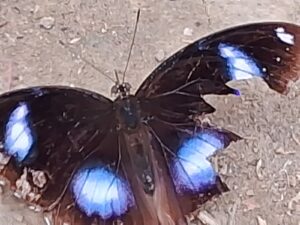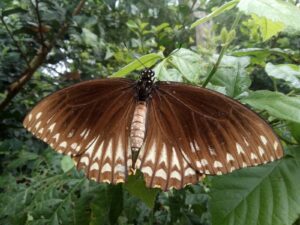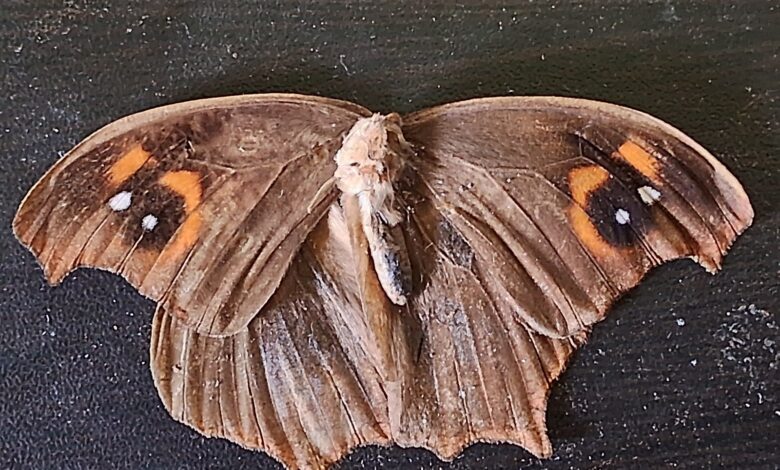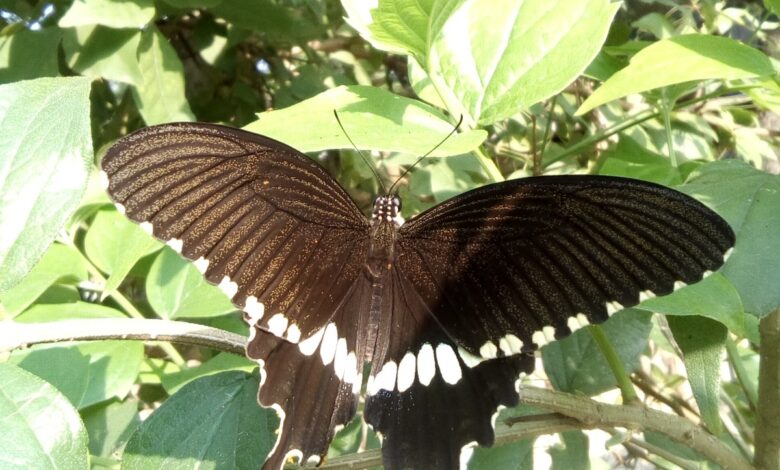Lepidoptera: Ecosystem Indicators and Premier Pollinators
News Mania Desk / Saikat Kumar Basu / 25th October 2024
There are 140,000 plus species of butterflies and moths reported around the world. Both of them belong to the Class- Insecta and Order Lepidoptera. Moths are the dominant members of the Order- Lepidoptera, representing approximately 85-90% of the order. Butterflies represent about 5-10% of the Order- Lepidoptera. The study of moths and butterflies is called Lepidopterology; and an expert on the study or collection of moths and butterflies is technically referred to as a Lepidopterist. The word ‘Lepidopterology’ is derived from three separate ancient Greek words. The word ‘lepídos’ in ancient Greek means scale’, the word ‘pterón’ means wing and ‘logia’ or ‘logos’ meaning study or discourse. Thus Lepidopterology refers to a specialized branch of Entomology (study of insects) that deals with specialized wing bearing, scaly insects like moths and butterflies.
Some of the common characteristics of both moths and butterflies constitute presence of the following attributes:
- Presence of exoskeleton
- Presence of minute scales on the body
- Body divided into three segments: head, thorax and abdomen
- Presence of three pairs of legs
- Presence of one pair of antennae
- Presence of one pair of wings
- Presence of compound eye
- Life cycle divided into four stages: egg, larva, pupa and adult
- Both are efficient natural cross pollinators
- Both are excellent indicators of ecosystem health
 Both are important indicators of healthy natural ecosystems and environment. Research indicates those specific biogeographic locations with rich diversity of moth and butterfly species are also co-inhabited by several other species of invertebrates; thereby enriching the local biodiversity. The overall rich biodiversity of such environment-friendly and farmer-friendly insects coexisting together enhances better ecological services in that particular ecosystem by helping in pest control as well as in natural cross pollination of many local plant species.
Both are important indicators of healthy natural ecosystems and environment. Research indicates those specific biogeographic locations with rich diversity of moth and butterfly species are also co-inhabited by several other species of invertebrates; thereby enriching the local biodiversity. The overall rich biodiversity of such environment-friendly and farmer-friendly insects coexisting together enhances better ecological services in that particular ecosystem by helping in pest control as well as in natural cross pollination of many local plant species.
 The presence of a rich biodiversity of insects like moths and butterflies enriches the food diversity and prey bases for several other predatory species of insects, birds, bats and other smaller mammals, reptiles and amphibians; and other insectivorous animals and plants. Butterflies and moths can therefore successfully support a wide diversity of many predators and parasites helping the growth of a healthy natural ecosystem; either specific to individual species, or a groups of species.
The presence of a rich biodiversity of insects like moths and butterflies enriches the food diversity and prey bases for several other predatory species of insects, birds, bats and other smaller mammals, reptiles and amphibians; and other insectivorous animals and plants. Butterflies and moths can therefore successfully support a wide diversity of many predators and parasites helping the growth of a healthy natural ecosystem; either specific to individual species, or a groups of species.
Ecologists have been studying butterflies for a considerable long period of time as efficient model organism for assessing environmental health to study the impacts of Climate Change, Global Warming, habitat loss, habitat fragmentation, and ecosystem degradation; and in better understanding various ecological successions, ecotones and ecological niches.
 Several moth species are active pollinators during the night. But not all of them are nocturnal. Some moth species like hummingbird moths are active during the day time. Nocturnal flowers that are pale (dull) or white in colour, growing in big clusters or aggregates, emitting strong or heavy fragrance, adequate nectar producers and with nectar glands located deep inside the flower base – attract moths for pollination in significantly large numbers. Flowers opening during late afternoon or night are best pollinated by moths. Hawk’s moths are outstanding natural fliers with tongues longer than their bodies. These specialized insects are capable of flying upwind, successfully tracking the airborne fragrance trail to their target flowers ready for natural cross pollination.
Several moth species are active pollinators during the night. But not all of them are nocturnal. Some moth species like hummingbird moths are active during the day time. Nocturnal flowers that are pale (dull) or white in colour, growing in big clusters or aggregates, emitting strong or heavy fragrance, adequate nectar producers and with nectar glands located deep inside the flower base – attract moths for pollination in significantly large numbers. Flowers opening during late afternoon or night are best pollinated by moths. Hawk’s moths are outstanding natural fliers with tongues longer than their bodies. These specialized insects are capable of flying upwind, successfully tracking the airborne fragrance trail to their target flowers ready for natural cross pollination.
 Butterflies are much better known member of the Order- Lepidoptera. Each one of us have seen and enjoyed the everlasting presence of butterflies in our nature, ecosystems, myths, legends traditions, folklores as well in literature, arts and culture. These farmer-friendly and eco- friendly vibrantly coloured insects have always been both part of our childhood memories as well as life experiences of our adulthood. Butterflies need salt and moisture in additional to plant sap and necatries from flowers for their survival. You may have seen them settling over in large numbers on the decaying dung, mud puddles, leaf surfaces, moist damp salty places while foraging between flowers. Female butterflies need this extra boost of salt for egg laying and maintaining their population dynamics. They have evolved to develop outstanding camouflage to protect them against their predators. Each butterfly species is dependent on 3-4 different species of plants for successfully completing their life cycle from laying eggs to emerging as adults.
Butterflies are much better known member of the Order- Lepidoptera. Each one of us have seen and enjoyed the everlasting presence of butterflies in our nature, ecosystems, myths, legends traditions, folklores as well in literature, arts and culture. These farmer-friendly and eco- friendly vibrantly coloured insects have always been both part of our childhood memories as well as life experiences of our adulthood. Butterflies need salt and moisture in additional to plant sap and necatries from flowers for their survival. You may have seen them settling over in large numbers on the decaying dung, mud puddles, leaf surfaces, moist damp salty places while foraging between flowers. Female butterflies need this extra boost of salt for egg laying and maintaining their population dynamics. They have evolved to develop outstanding camouflage to protect them against their predators. Each butterfly species is dependent on 3-4 different species of plants for successfully completing their life cycle from laying eggs to emerging as adults.
 The butterfly-plant interaction is one of the most important aspects of the life of a butterfly. They are distributed across tropics, sub tropics, sub temperate and even temperate areas in a wide diversity of specialized ecosystems. Butterflies successfully serve as pollinators as well as ecological indicators of sustainable health and stability of an ecosystem. Butterflies are excellent migrants like birds; and species like the Monarch butterflies of North America cover a distance of over of 2,500-3,000 miles to reach their target distance covering around 100 miles per day during their amazing migration.
The butterfly-plant interaction is one of the most important aspects of the life of a butterfly. They are distributed across tropics, sub tropics, sub temperate and even temperate areas in a wide diversity of specialized ecosystems. Butterflies successfully serve as pollinators as well as ecological indicators of sustainable health and stability of an ecosystem. Butterflies are excellent migrants like birds; and species like the Monarch butterflies of North America cover a distance of over of 2,500-3,000 miles to reach their target distance covering around 100 miles per day during their amazing migration.
 Unfortunately, just like bees and other insects; moths and butterflies have also been impacted by both natural and anthropogenic factors indirectly impacting their population dynamics. Several species are either extinct or has been pushed heavily towards extinction. The unprecedented growth of modern agriculture and industry with increasing human populations around the world has significantly reduced moths and butterflies from our ecosystem since they are extremely sensitive to changes to their immediate environment. The continuous and indiscriminate spraying of insecticides in our agricultural fields, infrastructural development and industrial growth, extreme air and water pollutions, rapid destruction and degradation of forests, lack of suitable foraging plants, Climate Change such as Global Warming and unpredictable weather patterns have all contributed towards the sad demise of moths and butterflies from our ecosystem. It is therefore important to educate people and make them aware of the important ecological roles played by moths and butterflies. We need to appreciate their roles and status in our ecosystems; and make sure that we take important steps like establishing several Pollinator Sanctuaries and Butterfly Gardens to protect our winged friends from the dangers of extermination and annihilation from our nature.
Unfortunately, just like bees and other insects; moths and butterflies have also been impacted by both natural and anthropogenic factors indirectly impacting their population dynamics. Several species are either extinct or has been pushed heavily towards extinction. The unprecedented growth of modern agriculture and industry with increasing human populations around the world has significantly reduced moths and butterflies from our ecosystem since they are extremely sensitive to changes to their immediate environment. The continuous and indiscriminate spraying of insecticides in our agricultural fields, infrastructural development and industrial growth, extreme air and water pollutions, rapid destruction and degradation of forests, lack of suitable foraging plants, Climate Change such as Global Warming and unpredictable weather patterns have all contributed towards the sad demise of moths and butterflies from our ecosystem. It is therefore important to educate people and make them aware of the important ecological roles played by moths and butterflies. We need to appreciate their roles and status in our ecosystems; and make sure that we take important steps like establishing several Pollinator Sanctuaries and Butterfly Gardens to protect our winged friends from the dangers of extermination and annihilation from our nature.
The differences between butterflies and moths are presented in the table below:
|
Moths |
Butterflies |
|
Smaller in size |
Bigger is size |
|
Mostly dull white or pale in colour |
More vibrant in colour |
|
Mostly nocturnal (active during night) |
Mostly diurnal (active during day) |
|
Moths flatten their wings horizontally while they ate resting |
Butterflies fold their wings over the back vertically during resting that appears like a tent |
|
Moths make soft cocoon from their secreted silk |
Butterflies produce a smooth hard structure called chrysalis and do not produce any silk like thread |
|
Stout and fuzzy antennae that has a highly distinguished feather or comb like structure |
Long and thin antennae terminating in club-shaped tips |
Plants attracting butterflies are as follows:
Ixora
Jasmine
Plumes cockscomb
Butterfly bush
Lantana
Verbena
Vervain
Sunflower
Asclepias
Common milkweed
Red milkweed
Showy milkweed
Morning glory
Alternanthera
Rose
Lavender
Mint
Tridax
Cosmos
Blue potterweed
Marigold
Chrysanthemum
Aster
Periwinkle
Flame of the forest


















